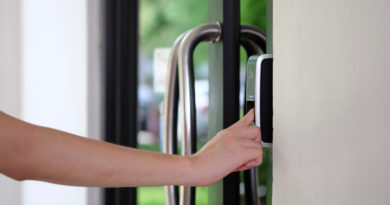Eliminate The Hassles Of ID Cards And PIN Codes With Biometric Identification Solutions
 Please enjoy this guest blog post from our Partner, Horizon Software. Horizon Software International is an innovative global leader in software, services and technologies for food service operations. The company, a Microsoft Gold Certified Partner headquartered near Atlanta, GA, offers comprehensive food service solutions including Point of Service (POS), inventory management, menu planning, procurement, production, digital signage, temperature management, integrated vending, and more.
Please enjoy this guest blog post from our Partner, Horizon Software. Horizon Software International is an innovative global leader in software, services and technologies for food service operations. The company, a Microsoft Gold Certified Partner headquartered near Atlanta, GA, offers comprehensive food service solutions including Point of Service (POS), inventory management, menu planning, procurement, production, digital signage, temperature management, integrated vending, and more.
This post was written by Amy Huff, SNS, Vice President, Marketing at Horizon Software.
Many schools are realizing that biometric identification is no longer a high-tech futuristic concept and that it can significantly increase serving line speeds in the cafeteria. Biometrics is a practical and affordable method of identification, removing the drawbacks associated with forgotten PINs, lost cards, and the potential for misuse due to bullying and other factors.
There are significant benefits to using biometrics for student identification:
Improve efficiency – Serving line speeds improve significantly when using biometrics rather than traditional identification methods. With biometrics, schools are able to avoid backed-up lunch lines due to misplaced cards or forgotten PIN codes. One school system tested PIN pads versus biometrics and found that biometric identification was two minutes faster per 100 transactions. With school cafeteria lines processing hundreds or thousands of students, those minutes really add up and make a difference in overall line speed.
Save time and money – A school’s staff no longer has to spend valuable time reissuing PIN codes and replacing forgotten, lost or stolen swipe cards. And, it’s not just time they are saving; schools also no longer have the cost of producing the cards.
Boost security and protect privacy – Unlike ID cards and PINs, students cannot steal another student’s biometric template to gain access to another student’s account.
With all these benefits, why aren’t all districts using biometric technology? The answer is that the biggest obstacle to using biometric technology is the misconception parents have in regard to what biometric technology is.
The misconception that students are being fingerprinted often hinders the adoption of this form of identification. It is important to convey to school districts that particular care has been taken to ensure personal privacy. Fingerprint images are NOT stored and the data is stored in a proprietary format, using secure encryption.
Instead of storing fingerprint images, the system stores only templates that are a numeric representation of the individual fingerprint. Templates can be used for matching, but the actual fingerprint cannot be reconstructed. Schools can rest assured that fingerprints are not stored anywhere and fingerprints cannot be recreated from the encrypted digital templates.
Beyond conveying this to school districts, it is even more important that the school districts communicate to parents when implementing biometric solutions. Once they realize their children are not being fingerprinted and that this technology makes it very difficult for another student to gain access to another’s meal account, it is easy for them to see the benefits.
Fingerprint recognition is becoming the recommended method for education environments in secondary schools because it is reliable, cost-effective, easy to use, and secure.












I am an advocate of the practical application of biometric technology for the realisation of firm benefits, and make my living in doing just that.
I do, though, have an issue with the use of biometrics in school environments.
In many of the application of biometrics in schools I have come across, the deployment has been done without consultation, with either the students or the parents.
In many cases, the students are too young to have a firm grasp of the implications, or an understanding of their rights on divulging private information.
I was concerned when my daughter informed me of a biometric deployment taking place in her school. It was only by chance that my daughter brought it up with me, and the school had made no effort to consult with the parents at all.
Often students will divulge their biometric details without thought, and in any case, the onus of consent falls with the parent or guardian, as the individuals providing biometric samples are more often than not minors.
Without a firm understanding of the biometric solution being used in my daughter’s school, and without having any access to details on how her private information was being safeguarded, I instructed my daughter not to provide her biometrics.
Alas, this has now seriously disenfranchised her as the school no longer accepts cash payments in the cafeteria, and payment can only be made by biometrics. Yes, you can opt out, but you opt out as the service as well.
If such systems can be implemented with complete transparency as to their deployment, and mechanisms to safeguard private information, and in a manner of involvement with the parents requiring proper consent to be provided whilst ensuring a standard level of continued service to those who choose to opt out, then I’m all for it.
Sadly, this is often not the case, and these systems are deployed with no warning and no consultation, only to be followed by an outcry.
Any system, in any environment, that is imposed upon users without the user’s involvement, will invariably lead to a lack of acceptance by those users.
Thank you for the comment and you certainly bring up some very valid points about the implementation of biometric identification technology in a school environment. We certainly do not advocate the deployment of these biometric systems without the necessary and proper communication with parents before the deployment in addition to their consent and total understanding of how their child’s personal information is being protected.
Here in the U.S., a majority of schools have to go through a rigorous vetting process for all purchases they make which in most cases includes letting the parents know about forthcoming purchases and justification of the purchase itself. You have an excellent point about transparency, it simply must be the key for any of these deployments to be successful and parental acceptance through education on how the technology works as well as the benefits that it brings to the school and to the children is mandatory.
We have dozens of testimonials from schools throughout the U.S. that use our technology that have seen distinct benefits from using biometrics with their lunch line point of service software. Not only does it speed up the lunch line, but it also helps prevent vandalism at vending machines and acts as a tool to help prevent students from bullying others for their PIN or ID card.
Your point is on target. We agree that with lack of communication and education on system operation, privacy and purpose leads to further lack of acceptance.
Thanks again for commenting.